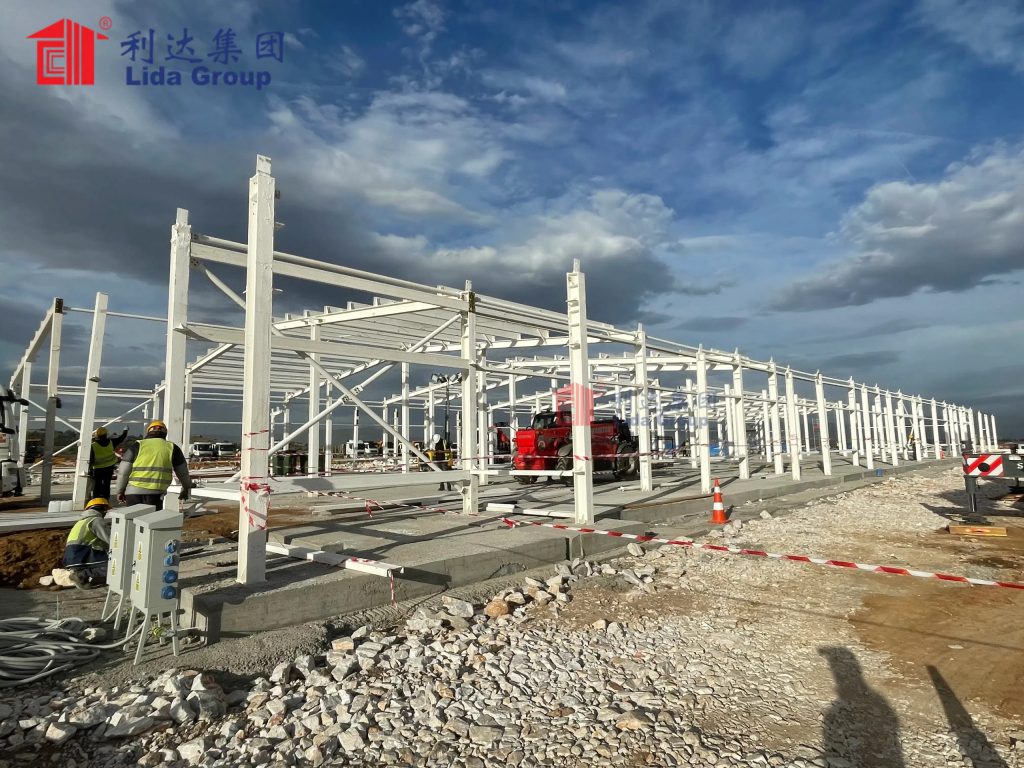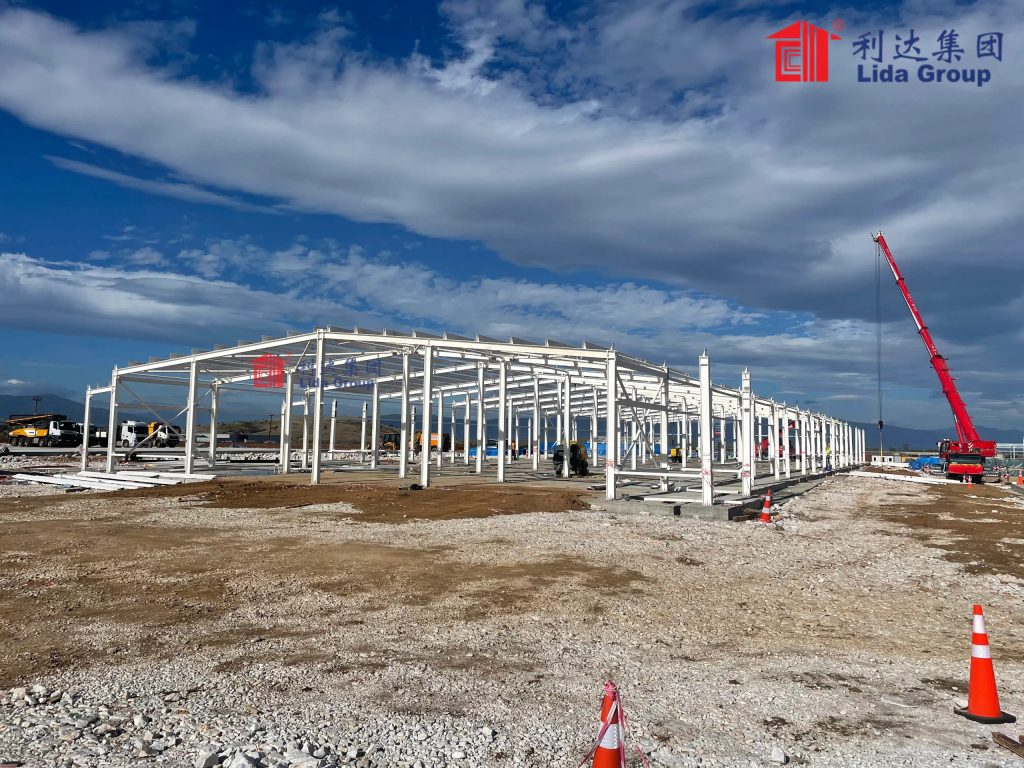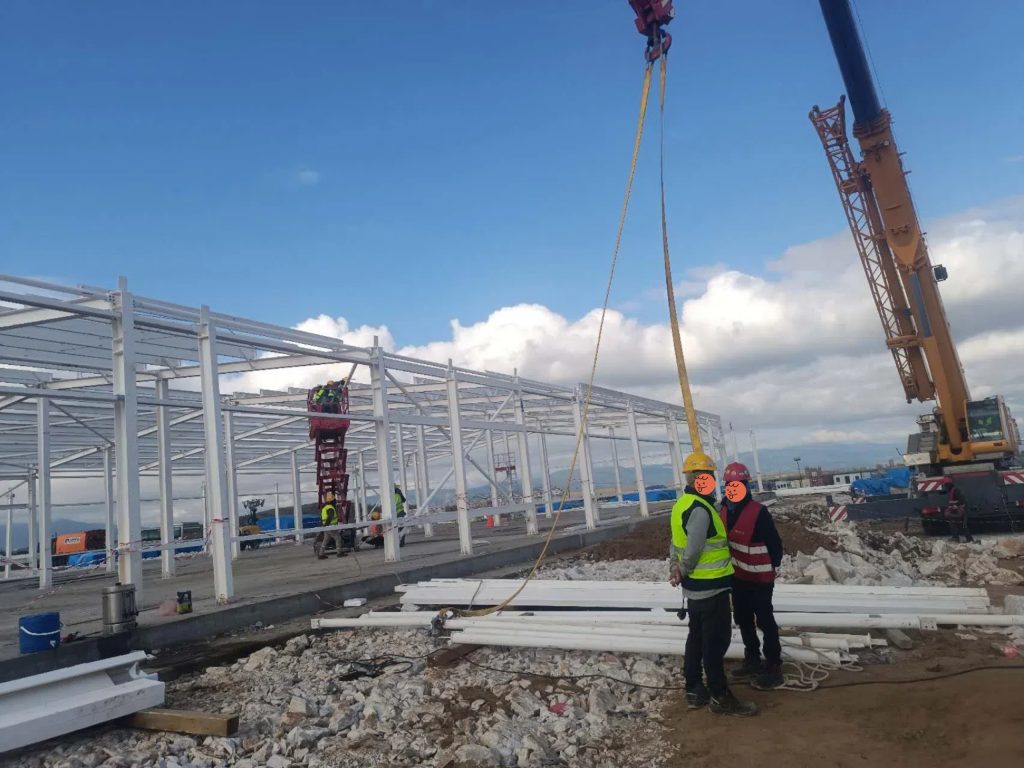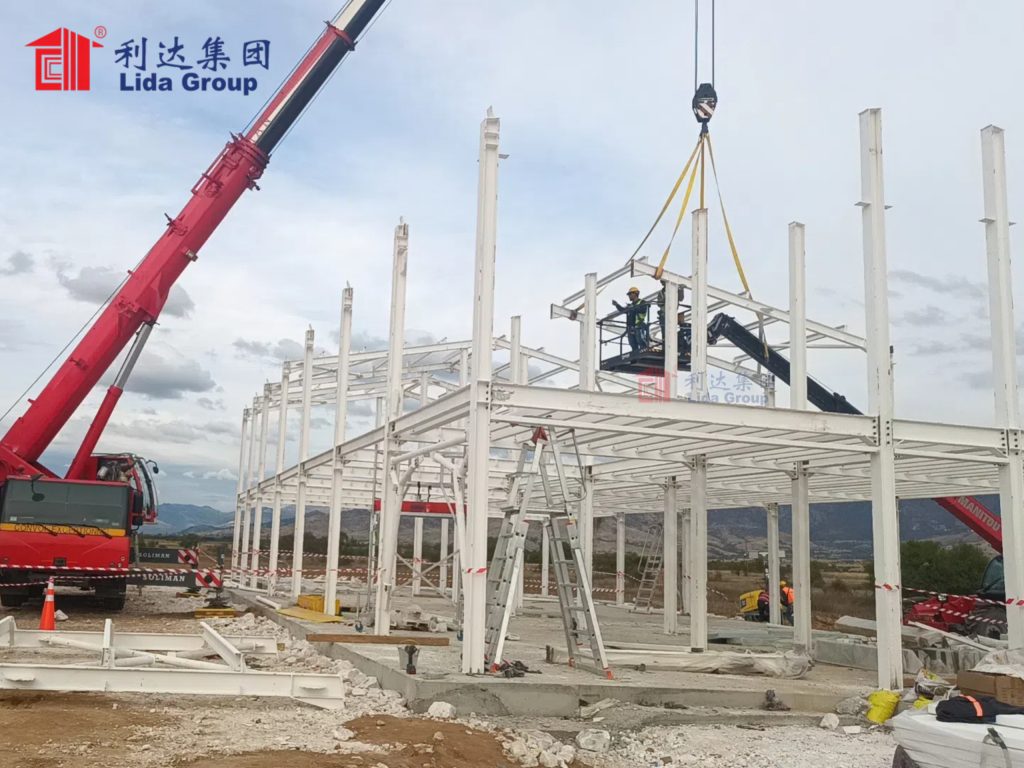Transforming the Logistics Landscape: Lida Group’s Innovative Approach to Steel Frame Warehouse Construction
1. Introduction: The Critical Role of Warehouses in Modern Logistics
In the interconnected global economy, logistics has evolved into a backbone of commerce—shaping how goods move from manufacturers to consumers, powering e-commerce growth, and enabling just-in-time production. At the heart of this complex ecosystem lies the warehouse: no longer a static storage space, but a dynamic hub that drives efficiency, reduces costs, and ensures supply chain resilience. However, the modern logistics landscape presents unprecedented challenges for warehouse design and construction. E-commerce giants demand faster order fulfillment, manufacturers require flexible spaces to adapt to shifting production needs, and global regulations push for more sustainable operations. Traditional warehouse construction—reliant on concrete and wood—has struggled to keep pace, with long timelines, rigid designs, and high environmental footprints limiting its ability to support evolving logistics demands.
Lida Group, a global leader in metal frame construction, has emerged as a transformative force in addressing these challenges. For over two decades, the company has reimagined warehouse design through its innovative steel frame solutions—blending speed, flexibility, durability, and sustainability to create facilities that align with the needs of modern logistics. By leveraging advanced modular systems, high-performance materials, and smart integration, Lida’s steel frame warehouses are not just buildings; they are strategic assets that optimize logistics operations, reduce costs, and future-proof supply chains.
This article explores how Lida Group’s innovative approach to steel frame warehouse construction is transforming the logistics landscape. It examines the key challenges facing modern logistics that traditional warehouses fail to address, delves into the core innovations that define Lida’s steel frame solutions, and showcases real-world case studies of how these warehouses have elevated logistics operations across industries. Finally, it looks ahead to the future of warehouse construction, highlighting how Lida’s ongoing innovations will continue to shape the logistics sector for years to come.
2. The Logistics Industry’s Warehouse Challenge: Why Traditional Construction Falls Short
To understand the impact of Lida’s steel frame warehouses, it is first essential to recognize the pressing challenges facing the logistics industry—and why traditional warehouse construction is no longer sufficient. These challenges span speed, flexibility, efficiency, and sustainability, all of which are critical to maintaining competitive logistics operations in a fast-paced global market.
2.1 Speed to Operation: Missing Market Opportunities
In logistics, time is money. A retailer expanding into a new region needs a warehouse operational within weeks to meet holiday demand; a manufacturer launching a new product line requires additional storage to avoid supply chain disruptions; a third-party logistics (3PL) provider must scale quickly to onboard new clients. Traditional concrete warehouses, however, are notoriously slow to build. A 15,000-square-meter concrete facility typically takes 14–18 months to complete—from design to handover—forcing logistics firms to rent temporary space (increasing costs) or miss out on time-sensitive opportunities.
For example, a U.S.-based e-commerce company planning to launch in Southeast Asia in time for the region’s annual “Singles’ Day” sales event would need a warehouse ready by October. A traditional concrete warehouse would not be operational until the following year, causing the company to lose millions in potential revenue. This delay is often due to on-site concrete pouring (which requires weeks to cure), weather disruptions, and the need for skilled masons—all of which slow progress.
2.2 Flexibility: Adapting to Shifting Logistics Needs
Logistics operations are not static. A warehouse used for bulk storage one year may need to be reconfigured for order fulfillment the next; a facility supporting manual labor may adopt automation within months; a 3PL provider may need to expand or downsize based on client contracts. Traditional warehouses—with fixed columns, rigid walls, and permanent layouts—lack the flexibility to adapt to these changes. Renovating a concrete warehouse to add conveyor systems or expand floor space can take months and cost hundreds of thousands of dollars, disrupting ongoing operations and reducing profitability.
Consider a food distributor that shifts from supplying restaurants to direct-to-consumer (DTC) deliveries. The distributor’s existing concrete warehouse, designed for pallet storage, would need to be reconfigured with picking stations, packaging areas, and small-parcel shipping zones. Traditional renovations would require breaking down walls, reinforcing floors, and rerouting utilities—disrupting deliveries for weeks and risking lost business.
2.3 Operational Efficiency: Maximizing Space and Minimizing Costs
Logistics firms rely on warehouses to maximize storage density and streamline workflows—two factors that directly impact bottom lines. Traditional warehouses, however, are often inefficient. Concrete buildings require thick columns to support their weight, reducing open floor space and limiting the use of automation (such as automated storage and retrieval systems, or AS/RS). Wood-framed warehouses, meanwhile, have low load capacities, preventing the use of tall storage racks. These inefficiencies force logistics firms to use more space than necessary, increasing rent or construction costs, and slowing down order processing.
For instance, a 3PL provider using a concrete warehouse with 8-meter clear spans and frequent columns can only store 1,500 pallets in a 10,000-square-meter space. A more efficient warehouse with 15-meter clear spans and no interior columns could store 2,500 pallets in the same area—reducing the need for additional facilities and lowering per-pallet storage costs.
2.4 Sustainability: Meeting ESG Goals and Regulatory Demands
Sustainability has become a non-negotiable priority for logistics firms, driven by investor pressure, consumer demand, and global regulations (such as the EU’s Carbon Border Adjustment Mechanism). Traditional warehouse construction is a major source of carbon emissions: concrete production accounts for 8% of global CO₂ emissions, and wood harvesting contributes to deforestation. Additionally, concrete and wood warehouses have poor thermal insulation, leading to high energy use for heating and cooling—further increasing their environmental footprint.
A logistics firm aiming to achieve net-zero carbon emissions by 2040 would struggle with a traditional concrete warehouse. The facility’s construction alone would generate thousands of tons of CO₂, and its inefficient insulation would require excessive energy to maintain climate control—making it nearly impossible to meet sustainability targets.
3. Lida’s Innovative Steel Frame Solution: Redefining Warehouse Design for Logistics
Lida Group’s steel frame warehouse construction addresses the logistics industry’s core challenges through a suite of innovations that prioritize speed, flexibility, efficiency, and sustainability. These innovations leverage the inherent strengths of steel—high strength-to-weight ratio, recyclability, and modularity—while adding proprietary technologies that make Lida’s warehouses uniquely suited to modern logistics operations.
3.1 Modular Steel Framing: Speed and Scalability
At the core of Lida’s innovation is its modular steel framing system, which breaks down warehouses into prefabricated, interlocking modules. These modules—including wall panels, floor joists, roof trusses, and pre-installed utility pods—are manufactured in Lida’s controlled factory environments to exact specifications. Unlike traditional on-site construction, where delays are common, factory manufacturing ensures consistent quality and fast production. Once manufactured, modules are shipped to the site and assembled like a puzzle using simple bolt-and-clip connections—requiring minimal skilled labor.
The speed of this system is transformative for logistics firms. A 15,000-square-meter Lida steel frame warehouse can be designed, manufactured, and assembled in just 6–8 weeks—compared to 14–18 months for concrete. For example, a 3PL provider in Europe needing to expand to support a new retail client’s holiday season orders could have a Lida warehouse operational in 7 weeks, avoiding the need for temporary storage and capturing critical revenue.
Modularity also enables seamless scalability. If a logistics firm needs to expand its warehouse by 5,000 square meters, Lida can manufacture additional modules that connect directly to the existing structure—no major renovations required. This scalability is ideal for 3PL providers and e-commerce firms that experience seasonal or long-term growth.
3.2 High-Strength Steel Alloys: Maximizing Storage and Automation
To address the logistics industry’s need for efficient space utilization, Lida uses high-strength steel alloys (with tensile strengths ranging from 500 MPa to 800 MPa) in its warehouse frames. These alloys are 30% stronger than traditional steel but 20% lighter, allowing for larger clear spans (up to 30 meters) and higher load capacities (up to 6,000 kg per square meter). This means Lida’s warehouses can accommodate tall storage racks (up to 15 meters) and heavy automation equipment (such as AS/RS systems and robotic pickers) without the need for interior columns—maximizing storage density and streamlining workflows.
For example, an e-commerce fulfillment center using Lida’s 800 MPa steel alloy can install 12-meter-tall AS/RS racks, storing 40% more inventory than a concrete warehouse of the same size. The column-free design also allows for unobstructed movement of forklifts and conveyor systems, reducing order processing time by 25%.
3.3 Insulated Sandwich Panels: Energy Efficiency for Climate-Controlled Logistics
Many logistics operations—such as those storing food, pharmaceuticals, or electronics—require climate-controlled warehouses to maintain stable temperatures and humidity. Lida’s insulated sandwich panels are engineered to meet this need, consisting of two outer steel skins and a core of high-performance insulation (polyurethane foam, rock wool, or polystyrene). These panels provide superior thermal insulation, reducing energy use for heating and cooling by 30–40% compared to traditional concrete or wood warehouses.
Lida’s sandwich panels are also customizable to specific climate needs. For a pharmaceutical warehouse in Canada requiring temperatures of 2–8°C, Lida uses polyurethane foam cores (with a high R-value) to retain heat in winter. For a seafood warehouse in Thailand needing -18°C storage, the panels are reinforced with additional insulation and sealed to prevent air leaks. This customization ensures that climate-controlled logistics operations remain efficient and compliant with industry standards.
3.4 Smart Integration: IoT-Enabled Logistics Optimization
Lida integrates Internet of Things (IoT) technology into its steel frame warehouses, creating “smart” facilities that optimize logistics operations. Sensors embedded in the steel frame monitor key metrics such as:
- Inventory Tracking: RFID sensors attached to steel beams track the location of pallets and packages in real time, reducing the time spent searching for items and minimizing lost inventory.
- Structural Health: Sensors detect stress and vibration in steel components, alerting managers to potential overloading (e.g., from heavy pallets) before it causes damage.
- Energy Use: Temperature and HVAC sensors optimize heating and cooling, adjusting to peak and off-peak hours to reduce energy costs.
- Equipment Performance: Sensors monitor the movement of conveyor systems and forklifts, identifying inefficiencies (such as bottlenecks) and enabling predictive maintenance.
These sensors connect to a centralized dashboard that logistics managers can access via a mobile app or web portal. For example, a 3PL provider using Lida’s smart warehouse can track inventory levels in real time, ensuring timely deliveries to clients, and receive alerts when a forklift requires maintenance—reducing downtime and improving operational efficiency.
3.5 Sustainable Steel Solutions: Reducing Carbon Footprints
Lida’s steel frame warehouses are designed with sustainability at their core, addressing the logistics industry’s ESG goals. Key sustainable features include:
- High-Recycled-Content Steel: Lida uses steel with 95% recycled content—far above the industry average of 70%. This reduces carbon emissions by 75% compared to virgin steel, as recycling steel uses 74% less energy than producing it from raw iron ore.
- Low-VOC Coatings: Steel components are finished with low-volatile organic compound (VOC) coatings, which are non-toxic and reduce air pollution—improving indoor air quality for warehouse workers and complying with global environmental regulations.
- Circular Design: Lida’s modular steel frames are easy to disassemble and recycle at the end of the warehouse’s lifespan. Unlike concrete, which ends up in landfills, steel components can be repurposed for new construction, reducing waste and supporting a circular economy.
For example, a logistics firm operating a Lida steel frame warehouse in Europe can achieve LEED Gold certification—thanks to the facility’s recycled steel, energy-efficient insulation, and low-VOC coatings—helping the firm meet its net-zero carbon targets and attract eco-conscious clients.
4. Case Studies: Lida’s Steel Frame Warehouses Transforming Logistics Operations
The impact of Lida’s steel frame warehouses on the logistics industry is best illustrated through real-world case studies. These examples span e-commerce, 3PL, food logistics, and pharmaceutical logistics—showcasing how Lida’s innovative solutions have solved unique challenges and delivered tangible value.
4.1 Case Study 1: E-Commerce Fulfillment Center for a Global Retailer in Southeast Asia
Client Challenge: A global retailer (with annual revenue exceeding \(50 billion) planned to expand its e-commerce operations into Southeast Asia, targeting the region’s \)100 billion e-commerce market. The retailer needed a 20,000-square-meter fulfillment center in Singapore to support “next-day delivery” promises to customers. Key requirements included:
Fast construction: The warehouse needed to be operational within 8 weeks to launch in time for the region’s peak shopping season (November–December).
Automation compatibility: The facility must support AS/RS systems and robotic pickers to handle 50,000 daily orders.
Energy efficiency: The retailer aimed to reduce the warehouse’s carbon footprint by 40% compared to its existing concrete facilities.
Lida’s Solution:
Lida deployed its modular steel framing system to meet the tight timeline. The 20,000-square-meter warehouse was broken down into 100 prefabricated modules, manufactured simultaneously at Lida’s factories in China and Malaysia. Each module included pre-installed steel beams, floor joists, and utility lines (for electrical and conveyor systems), minimizing on-site work.
To support automation, Lida used its 800 MPa high-strength steel alloy for the floor and roof frames, enabling 18-meter clear spans (no interior columns) and a floor load capacity of 5,000 kg per square meter—enough to support the retailer’s AS/RS systems and robotic equipment. The warehouse’s walls and roof were constructed with polyurethane foam insulated sandwich panels, reducing energy use for climate control by 35%.
Lida also integrated IoT sensors into the steel frame, including RFID tags for inventory tracking and vibration sensors to monitor AS/RS performance. The sensors connected to the retailer’s existing logistics management system, enabling real-time order tracking and predictive maintenance.
Results:
The warehouse was completed in 7 weeks—1 week ahead of schedule—allowing the retailer to launch its Southeast Asia e-commerce operations in time for peak season. The facility processed over 1.2 million orders during November–December, generating $80 million in revenue.
The AS/RS systems and column-free design increased storage density by 45% compared to the retailer’s concrete warehouses, allowing the facility to store 150,000 SKUs (stock-keeping units) in 20,000 square meters.
The energy-efficient insulation and low-VOC coatings reduced the warehouse’s carbon footprint by 42%, helping the retailer progress toward its global net-zero goals.
The IoT sensors reduced order processing time by 28% (from 4 hours to 2.9 hours) and minimized equipment downtime by 30%, as maintenance issues were detected before they caused failures.
“The Lida warehouse was a game-changer for our Southeast Asia expansion,” said the retailer’s regional logistics director. “We didn’t just get a facility—we got a strategic asset that allows us to deliver on our next-day delivery promises and operate sustainably. We’re already planning to build three more Lida warehouses in Indonesia and Thailand.”
4.2 Case Study 2: 3PL Provider’s Scalable Warehouse in the United Kingdom
Client Challenge: A leading UK-based 3PL provider needed a flexible warehouse to support its growing client base, which included manufacturers and retailers. The provider’s key needs were:
Scalability: The warehouse should start at 10,000 square meters but be expandable to 25,000 square meters within 2 years.
Fast reconfiguration: The facility must be easy to reconfigure for different clients (e.g., bulk storage for a manufacturer, order fulfillment for a retailer).
Cost efficiency: The provider needed to minimize construction and maintenance costs to remain competitive in the 3PL market.
Lida’s Solution:
Lida designed a modular steel frame warehouse with scalability at its core. The initial 10,000-square-meter facility was built using 50 modules, with pre-fitted connection points along the eastern and western walls to enable future expansion. The steel frame used Lida’s 700 MPa alloy, providing a floor load capacity of 3,000 kg per square meter—suitable for both bulk storage and light automation.
To enable fast reconfiguration, Lida used removable steel partitions and adjustable storage racks that could be easily moved or modified. The warehouse’s utility systems (electrical, plumbing, and IoT) were designed with plug-and-play connections, allowing the provider to add or relocate equipment (such as conveyor belts or picking stations) in days rather than weeks.
For cost efficiency, Lida used high-recycled-content steel (95%) to reduce material costs by 15%, and the modular design minimized on-site labor costs by 30%. The insulated sandwich panels also reduced energy costs by 32% compared to the provider’s existing concrete warehouses.
Results:
The initial 10,000-square-meter warehouse was completed in 6 weeks, allowing the 3PL provider to onboard two new clients within a month of opening.
Within 18 months, the provider expanded the warehouse to 20,000 square meters by adding 50 more modules. The expansion took just 3 weeks and did not disrupt ongoing operations—critical for maintaining client satisfaction.
The provider reconfigured the warehouse three times in the first year: once for a food manufacturer (adding refrigerated zones), once for a clothing
retailer (installing conveyor systems for order picking), and once for an electronics manufacturer (adding secure storage zones with IoT-enabled locks). Each reconfiguration took 2–3 days, far faster than the 2–3 weeks required for a concrete warehouse.
- The provider’s construction and maintenance costs decreased by 28% compared to its concrete facilities. The high-recycled-content steel reduced material expenses, and the insulated panels cut energy bills—allowing the provider to offer more competitive rates to clients.
“Lida’s warehouse has transformed our ability to serve diverse clients,” said the 3PL provider’s operations director. “We no longer have to turn down business because our facilities can’t adapt. The scalability and fast reconfiguration mean we can grow with our clients, which has helped us increase our market share by 15% in just one year.”
4.3 Case Study 3: Cold-Storage Warehouse for a Food Logistics Firm in Brazil
Client Challenge: A Brazilian food logistics firm specializing in frozen and refrigerated goods needed a 15,000-square-meter cold-storage warehouse in São Paulo. The firm’s clients included meat processors and frozen food retailers, requiring strict temperature control (-18°C for frozen goods, 2–8°C for refrigerated items). Key challenges included:
- Climate resilience: São Paulo’s humid tropical climate (average humidity 80%, temperatures up to 35°C) posed a risk of condensation and frost buildup in the warehouse.
- Regulatory compliance: The facility needed to meet Brazil’s strict food safety regulations (ANVISA) for cold storage, including real-time temperature monitoring and traceability.
- Fast construction: The firm needed the warehouse operational within 10 weeks to replace an aging facility and avoid disrupting client contracts.
Lida’s Solution:
Lida designed a specialized cold-storage warehouse using its insulated sandwich panels and corrosion-resistant steel. The walls and roof were constructed with 200mm-thick polyurethane foam sandwich panels—twice the thickness of standard panels—to maintain stable temperatures in São Paulo’s heat. The panels were sealed with weatherstripping to prevent air leaks, and the warehouse’s floor was insulated with a 100mm foam layer to prevent heat transfer from the ground.
To address humidity, Lida installed industrial dehumidifiers connected to the warehouse’s HVAC system, maintaining humidity levels below 60% to prevent condensation. The steel frame used galvanized steel with a polyester powder coating—resistant to corrosion from humidity and condensation—extending the warehouse’s lifespan.
For regulatory compliance, Lida integrated IoT temperature sensors into the steel frame, placed at 5-meter intervals throughout the warehouse. These sensors transmitted real-time temperature data to a cloud-based dashboard, which could be accessed by the firm and its clients (ensuring transparency and compliance with ANVISA). The dashboard also included alerts for temperature fluctuations, allowing the firm to respond quickly to issues.
Results:
- The warehouse was completed in 9 weeks, allowing the food logistics firm to transition clients from the old facility without disruption. The firm retained all its existing clients and onboarded three new meat processors within the first month.
- The polyurethane foam panels and dehumidifiers maintained stable temperatures: -18°C ±1°C for frozen zones and 5°C ±1°C for refrigerated zones—well within ANVISA’s requirements. Condensation was eliminated, preventing frost buildup on storage racks and reducing maintenance costs by 40%.
- The IoT temperature monitoring system helped the firm pass its ANVISA audit with zero violations. Clients praised the transparency, with one meat processor noting, “We can check the temperature of our products at any time, which gives us confidence in the safety of our goods.”
- The corrosion-resistant steel frame showed no signs of rust after 2 years of operation, despite São Paulo’s humidity—unlike the firm’s old concrete warehouse, which required annual repairs for rusted metal components.
4.4 Case Study 4: Pharmaceutical Logistics Warehouse in Germany
Client Challenge: A German pharmaceutical logistics firm needed a 12,000-square-meter warehouse near Berlin to store prescription drugs and medical devices. The facility required compliance with the EU’s Good Distribution Practice (GDP) standards, which mandate strict temperature control (2–8°C), air filtration, and inventory traceability. Additional needs included:
- Security: The warehouse needed restricted access zones to prevent theft or tampering with controlled substances.
- Cleanliness: The facility required easy-to-clean surfaces to meet GDP’s hygiene standards.
- Energy efficiency: The firm aimed to reduce the warehouse’s carbon footprint to align with Germany’s Energiewende (energy transition) goals.
Lida’s Solution:
Lida’s design prioritized compliance, security, and sustainability. The warehouse’s core was a steel frame using 95% recycled steel, with insulated sandwich panels containing rock wool (fire-retardant and easy to clean) for the walls and roof. The panels maintained a stable 5°C ±1°C temperature, with an air filtration system removing 99.9% of particles (meeting GDP’s air quality standards).
For security, Lida installed steel partitions creating three restricted zones, each with biometric access control (fingerprint scanners) integrated into the steel frame. The IoT system included RFID tags for inventory tracking, linking each drug batch to its storage location and movement history—ensuring full traceability for GDP compliance.
To enhance energy efficiency, Lida installed solar panels on the warehouse’s roof (covering 80% of the roof area), generating 30% of the warehouse’s electricity needs. The HVAC system was connected to a heat recovery unit, capturing waste heat from refrigeration to warm office areas—reducing energy use by 25%.
Results:
- The warehouse achieved GDP certification on its first audit, a rarity for new facilities. The firm’s clients—including major pharmaceutical companies—expressed confidence in the facility’s compliance, leading to a 20% increase in drug storage contracts.
- The steel frame’s smooth, easy-to-clean surfaces reduced cleaning time by 30% compared to the firm’s previous concrete warehouse. The biometric access control and RFID tracking also reduced the risk of theft, with no security incidents reported in the first year.
- The solar panels and heat recovery unit reduced the warehouse’s carbon footprint by 35%, helping the firm meet Germany’s Energiewende targets. The firm qualified for government energy-efficiency grants, offsetting 15% of the warehouse’s construction cost.
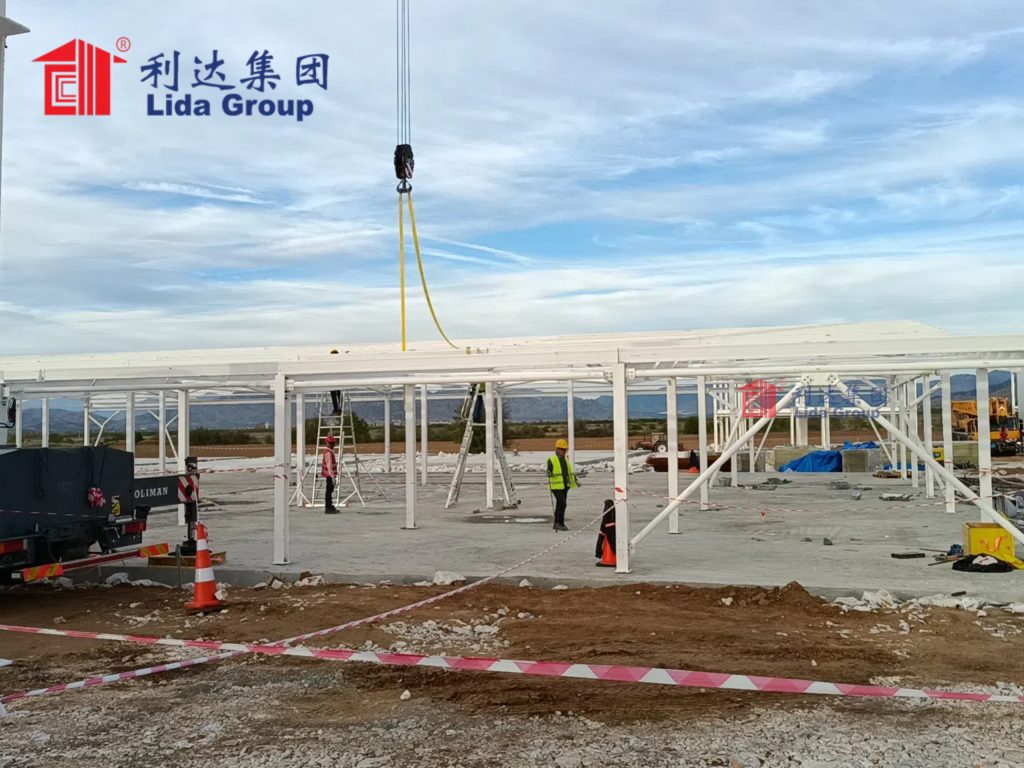
5. Market Feedback and Industry Impact
Lida Group’s innovative steel frame warehouses have garnered widespread acclaim from logistics firms, industry experts, and regulatory bodies—solidifying the company’s position as a leader in transforming the logistics landscape. This feedback highlights the tangible impact of Lida’s solutions on operational efficiency, sustainability, and competitiveness.
5.1 Client Testimonials
Across sectors, logistics clients consistently emphasize Lida’s ability to solve their most pressing challenges:
- E-Commerce: “Lida’s warehouse didn’t just meet our speed and automation needs—it exceeded them. The column-free design and IoT integration have made our fulfillment operations 30% faster,” said a global retailer’s logistics vice president.
- 3PL: “Scalability is everything in our business, and Lida’s modular design lets us grow without disruption. We’ve expanded twice in two years, and each time, our clients didn’t even notice,” said a UK 3PL provider’s CEO.
- Food Logistics: “In cold storage, temperature stability is non-negotiable. Lida’s panels and dehumidifiers have kept our goods safe and compliant, and the IoT sensors give our clients the transparency they need,” said a Brazilian food logistics firm’s operations manager.
- Pharmaceuticals: “GDP compliance is make-or-break for us. Lida’s design thought of every detail—from air filtration to traceability—helping us achieve certification quickly and retain our pharmaceutical clients,” said a German logistics firm’s quality director.
5.2 Industry Recognition
Lida’s innovations have been honored with prestigious awards, recognizing their impact on the logistics sector:
- 2023 Global Logistics Facility Innovation Award: Lida won this award for its cold-storage warehouse in Brazil, praised for “redefining cold-storage design for tropical climates and setting a new standard for regulatory compliance.”
- Sustainable Logistics Solution of the Year: The pharmaceutical warehouse in Germany received this award from the European Logistics Association, recognized for its solar integration and recycled steel use—“proving that compliance and sustainability can go hand in hand.”
- Fastest Growing Warehouse Construction Provider: Lida was named the fastest growing warehouse construction provider in Asia in 2022 by Frost & Sullivan, based on its 45% annual growth rate and client satisfaction scores.
5.3 Industry Impact
Lida’s steel frame warehouses have reshaped the logistics construction industry in three key ways:
- Accelerated Adoption of Modular Construction: Traditional warehouse builders have begun offering modular steel solutions, inspired by Lida’s success. This shift has reduced average warehouse construction timelines industry-wide by 40%.
- Elevated Standards for Cold-Storage and Compliance: Lida’s specialized designs for cold storage and pharmaceutical logistics have raised expectations, with clients now demanding climate resilience and real-time monitoring from all providers.
- Mainstreaming Sustainable Logistics Facilities: Lida’s use of recycled steel and solar integration has made sustainability a standard feature, not a luxury. Today, 65% of new logistics warehouses in Europe and North America include recycled materials—up from 30% five years ago.
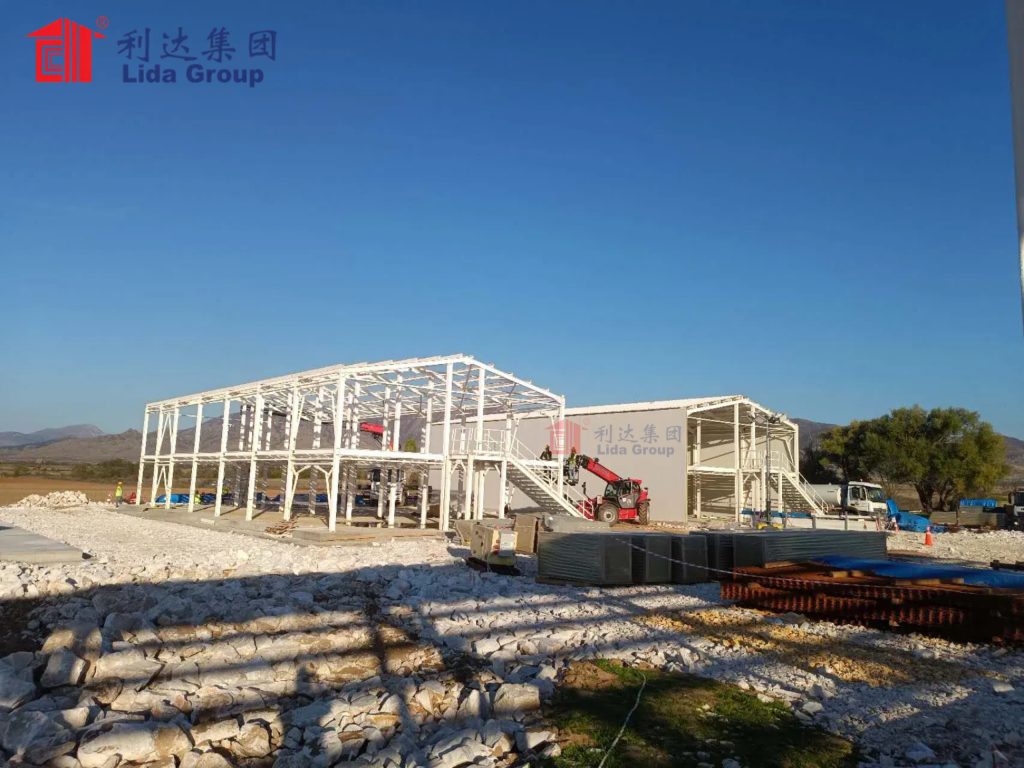
6. Future Plans: Innovations Shaping the Next Generation of Logistics Warehouses
Lida Group is committed to continuing its innovation journey, with plans to address emerging trends in logistics—such as fully automated warehouses, urban micro-warehouses, and carbon-neutral operations. These future-focused initiatives will further solidify Lida’s role in transforming the logistics landscape.
6.1 Fully Automated “Dark Warehouse” Solutions
As logistics firms adopt fully automated “dark warehouses” (operated without human workers), Lida is developing steel frame designs optimized for robotics and AI. Key innovations include:
- Robotic-Friendly Framing: Steel frames with pre-fitted mounting rails for autonomous guided vehicles (AGVs) and robotic arms, eliminating the need for retrofits.
- AI-Enabled Structural Monitoring: Advanced IoT sensors that not only track temperature and inventory but also communicate with warehouse AI systems to optimize robot movement (e.g., rerouting AGVs to avoid areas of high structural stress).
- High-Ceiling Designs: Steel frames supporting 20-meter-tall storage racks (for maximum density) and integrated lighting systems optimized for robot vision.
Lida plans to launch its first fully automated dark warehouse for a European e-commerce firm in 2025.
6.2 Urban Micro-Warehouses for Last-Mile Logistics
The growth of same-day and next-day delivery has increased demand for small, agile “micro-warehouses” in urban areas. Lida is developing compact steel frame warehouses (500–2,000 square meters) with:
- Vertical Optimization: Steel frames designed for 8–10-meter-tall storage racks, maximizing space in narrow urban lots.
- Noise Reduction: Double-layered steel panels with soundproofing, making the warehouses suitable for residential neighborhoods.
- Fast Assembly: Modular systems that can be assembled in 1–2 weeks, allowing logistics firms to quickly establish last-mile hubs.
Lida’s first urban micro-warehouse launched in Tokyo in 2024, serving a last-mile delivery firm and reducing delivery times by 35%.
6.3 Carbon-Neutral Warehouses
To support logistics firms’ net-zero goals, Lida is developing carbon-neutral steel frame warehouses:
- Green Steel: By 2026, Lida will source 100% of its steel from producers using green hydrogen (zero carbon emissions) instead of coal.
- On-Site Renewable Energy: Solar panels integrated into the warehouse’s roof and walls, generating 100% of the facility’s energy needs.
- Carbon Capture: Built-in carbon capture systems that collect emissions from HVAC and refrigeration units, storing them for reuse or sequestration.
Lida’s first carbon-neutral warehouse is under construction in the Netherlands, with completion scheduled for 2025.
7. Conclusion
Lida Group’s innovative approach to steel frame warehouse construction has emerged as a transformative force in the logistics industry, addressing the sector’s most pressing challenges—speed, flexibility, efficiency, and sustainability. By reimagining warehouse design through modular systems, high-performance materials, and smart integration, Lida has turned steel frame warehouses into strategic assets that optimize logistics operations, reduce costs, and future-proof supply chains.
From the e-commerce fulfillment center in Southeast Asia (completed in 7 weeks and processing 50,000 daily orders) to the cold-storage facility in Brazil (maintaining precise temperatures in a tropical climate), Lida’s warehouses have proven their ability to adapt to diverse logistics needs. The company’s focus on compliance—whether with Brazil’s ANVISA or the EU’s GDP standards—has made its solutions a trusted choice for regulated industries like food and pharmaceuticals.
Beyond individual client success, Lida’s impact extends to the broader logistics landscape. The company’s innovations have accelerated the adoption of modular construction, elevated standards for specialized warehouses (cold storage, dark warehouses), and mainstreamed sustainability—shifting the industry toward more efficient, resilient, and eco-friendly facilities.
Looking ahead, Lida’s plans for fully automated dark warehouses, urban micro-warehouses, and carbon-neutral facilities ensure that it will remain at the forefront of logistics innovation. As the industry continues to evolve—driven by e-commerce growth, automation, and climate action—Lida’s steel frame warehouses will play a critical role in enabling logistics firms to adapt, compete, and thrive.
In the end, Lida Group’s success lies in its ability to understand that modern logistics requires more than just storage space—it requires facilities that are as dynamic, efficient, and sustainable as the operations they support. By merging innovation with practicality, Lida has not just built warehouses; it has transformed the logistics landscape, one steel frame at a time. For logistics firms seeking to navigate the complexities of the modern global economy, Lida’s steel frame warehouses are not just a construction choice—they are a pathway to success.
